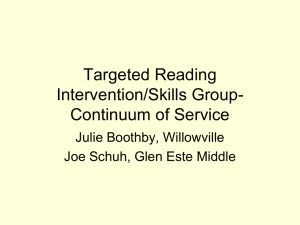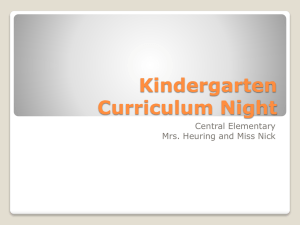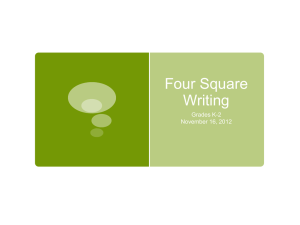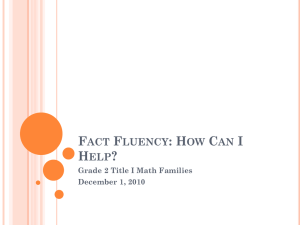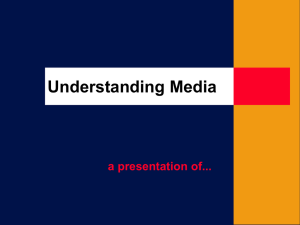Progress Monitoring Overview - Killeen Independent School District
advertisement
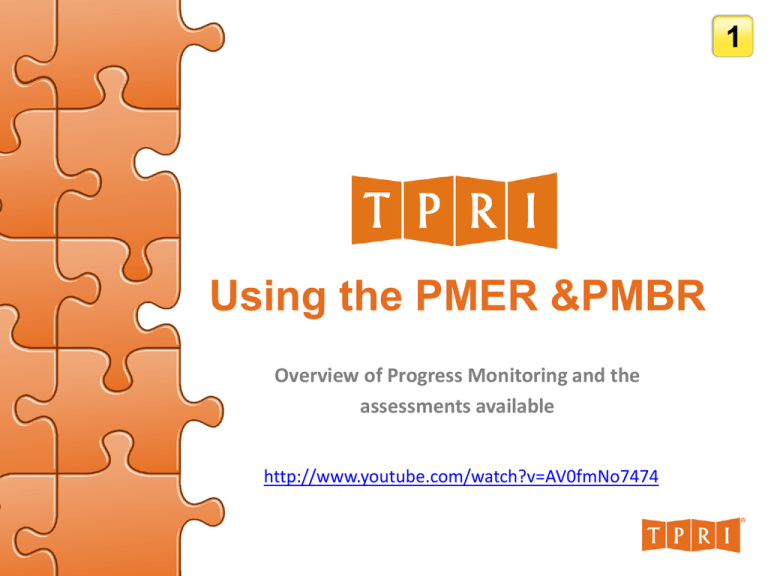
1 Using the PMER &PMBR Overview of Progress Monitoring and the assessments available http://www.youtube.com/watch?v=AV0fmNo7474 Copyright Notification 2 The contents of this presentation are to be used only to facilitate TPRI Training-of-Trainers and teacher training. The materials are copyrighted by the University of Texas System and the Texas Education Agency. Without the express written permission of the University of Texas System and the Texas Education Agency the materials may not be reproduced in any form for any purpose other than delivering TPRI training. You may not sell or use the materials in any other capacity. 9 SECTION 1: WHY? Goal: Clarify the purpose of the PM kits. 9 Turn and Talk Turn and Talk with a partner about what we know about Student A and Student B. High Grade Level General Reading Performance Intervention Begins Low Beginning Of Year Middle Of Year Time of Year End Of Year 4 Why Progress Monitor? The purpose of a progress monitoring assessment is to help teachers work with students so that the outcome for a student like student B is more like this: High Grade Level General Reading Performance Intervention Intensifies Low Intervention Begins Beginning Of Year Intervention Begins Middle Of Year Time of Year End Of Year 5 What is a Progress Monitoring Assessment? 10 Progress Monitoring Assessments are assessments used to help teachers determine whether students are responding to instruction. Progress Monitoring Assessments are usually: • Administered every 2 or 3 weeks • Brief (take a few minutes or so to administer) • Used with students who are struggling and/or receiving extra help (Intervention) • Matched with the instruction students are receiving Progress Monitoring & Other Types of Assessments 11 • The TPRI includes three types of assessments: Screening, Benchmark and Progress Monitoring. • For more information, review: – Assessment Types Handout Progress Monitoring and RTI 12 RTI = Response to Intervention OR Response to Instruction a framework for effectively addressing the instructional needs of all students in a school. • Different students get different types and amounts of instruction. • Instruction is research based. • Assessment helps us know what instruction to give and whether it is working. Review the RTI Handout towards the back of your packet for more information on Progress Monitoring and RTI. Goals for This Training 6 Why Clarify the purpose of the PMER & PMBR kits. What Learn what is assessed on the PMER & PMBR. How Discover when and how to administer the PMER & PMBR kit with students and practice giving parts of the assessment. What Next Explore the implications for instruction of PMER & PMBR results. Why Main Idea We use progress monitoring assessments with struggling students to be sure our instruction is working, and so we can make adjustments if it is not. 13 13 SECTION 2: WHAT? Goal: Learn about the progress monitoring assessments available. What is the PMER? • The PMER is used with students: – Who are not meeting grade level standards. – Who are receiving intervention instruction in reading. • Assesses key skills related to early reading: Phonics, Phonemic Awareness and Listening Comprehension. • Sets of tasks administered to students every 2 weeks. 14 What Skills are Assessed on the PMBR? 15 The PMBR assesses reading: • Fluency in WCPM (rate, but not prosody) • Accuracy – Percent of words read correctly – Teachers assess accuracy on the PMBR by marking the words a student reads incorrectly. • Comprehension – Assessed on the PMBR by asking students questions about what they read. Why Fluency? 16 Turn and Talk: What abilities does a student need to have in order to read fluently? How does reading fluently help readers? To read fluently, students need to… Reading fluently helps readers… – Read with – Instantly recognize comprehension many words – Stay motivated or – Decode unknown maintain interest in words quickly reading – Have strategies for what to do when – Build a stronger they encounter vocabulary unknown words Fluency, Comprehension & Vocabulary 17 There is a close and important relationship between the development of fluency, comprehension and vocabulary. Review the Fluency, Comprehension and Vocabulary Handout towards the back of your packet for more information about these relationships. What Main Idea We assess fluency because it is quick and easy to assess, and it is closely tied to phonics, word recognition, vocabulary and comprehension. 18 19 SECTION 3: HOW? Goal: Discover when and how to administer the PM kits with students. PMER Kit Materials 16 Giving the PMBR: What You’ll Need 20 Ensuring Correct and Consistent Administration Reminders for administering the PMBR: • Student sits to your side and slightly in front. • Introduce each task using the script. • Have your stopwatch ready. • Be positive and encouraging. • Don’t give specific feedback. 21 Administration Schedules: 2-Week and 6-Week 2-Week Schedule 6-Week Schedule Use With Struggling readers “Average” readers Frequency Every 2 weeks Every 6 weeks Story Selection Method Begin with story 1 Word List for story placement Length of Reading 2 minutes Entire story Assessing Comprehension 2 generic questions 6 story specific questions 22 When is the PMER administered? • Used in Kindergarten and Grade 1 – Typically in Grade 1 it is used just between BOY and MOY. – Typically in Kinder it is used just between MOY and EOY. • Begin use 2 weeks after BOY and MOY assessments are completed. • Assess students every 2 weeks. 17 47 Goal: Explore the implications for instruction of PM results. Completing the Student Data Form 10/3 1 1 Inst. 45 X X 48 Completing the Student Progress Chart 49 The “Quick Review” Sheet At the back of your packet there’s a Quick Review sheet. Tear off this sheet, fold it in half and stick it in your Teacher’s Guide for reference while administering the assessment. 47 How do I use the PMBR to help plan 50 instruction? Slow progress with fluency suggests a need for work with one or more of the following: • Decoding (phonics) • Sight Words • Fluency Use the GK and Fluency Sections of the TPRI Intervention Activities Guide to plan additional instruction in these areas. How Do Students Improve Fluency? 51 • The primary strategy for developing reading fluency is to provide extensive reading opportunities for reading aloud with text at each student’s independent or instructional level. • Feedback from more skilled readers and models of fluent reading are critical for improving reading fluency. Questions 48 TPRI Website and Contact Information • For more information, IAG Blackline Masters and updates or news go to http://tpri.org. • All TPRI questions can be emailed to tpri@uth.tmc.edu. 49 Additional Training Modules The purpose of TPRI is to provide information that helps teachers teach! TEA Recommends that all professionals administering or using TPRI should complete, at a minimum: Administration Module Grouping Students Using the Intervention Guide There are also training modules for: Analyzing word reading and spelling results Progress Monitoring kits 50 Summary of Main Ideas 51 Why We use progress monitoring assessments with struggling students to be sure our instruction is working, and so we can make adjustments if it is not. What The PMER measures students progress with important skills related to early reading: phonemic awareness, phonics and listening comprehension. How Teachers determine whether to give an optional task to a student based on whether they need additional instructional information for the student. In general, optional tasks should be given when they assess skills that are a current focus of instruction. What Next There are four aspects of instruction we can modify. –Type –Pace –Frequency –Intensity Summary of Main Ideas 57 Why – We use progress monitoring assessments with struggling students to be sure our instruction is working, and so we can make adjustments if it is not. What – We assess fluency because it is quick and easy to assess, and it is closely tied to phonics, automaticity, vocabulary and comprehension. How – There are three rules for selecting a story on the 2-Week Schedule when moving from one administration to the next. –Present the next story. –The student may attempt no more than 2 stories in an administration. –A story can be the final story only twice. What Next – To determine progress, consider story grade level, story difficulty (number) and fluency rate. If fluency progress is slow, changes can be made to some or all aspects of the instruction a student receives: –Type –Pace –Frequency –Intensity http://www.youtube.com/watch?v=R5IhYLxSqhg


